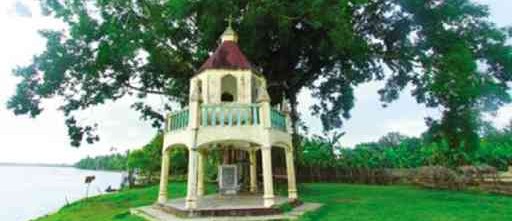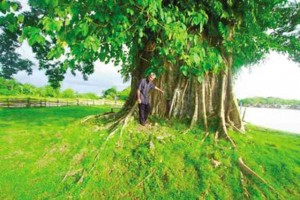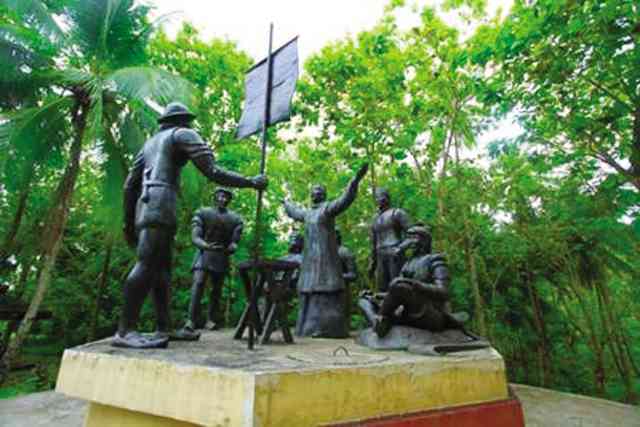

BUTUAN CITY—Easter Sunday fell on March 31—exactly as it was in 1521, when Ferdinand Magellan went ashore on an island called Mazaua and asked his chaplain to celebrate what became known as the first Mass in the Philippines.
Commemorating this uncanny coincidence on March 31, eight years shy of the 500th anniversary of Magellan’s Easter Mass, was the Diocese of Butuan, with a concelebrated Mass by the clergy under the aegis of Bishop Juan de Dios Pueblos at 9 a.m. at the Cathedral-Shrine of St. Joseph in this city’s downtown area.
“Official Philippine history says the first Mass was held in Limasawa, but Catholic historiography and tradition point to Butuan as the site of this first Eucharistic celebration in the Philippines,” said Fr. Joesilo Amalla, of the Diocese of Butuan, whose scholarly work “Mazaua Controversy: Truth Uncovered,” commissioned by the then president of the Catholic Bishops Conference of the Philippines (CBCP), Bishop Nereo Odchimar of Tandag, Surigao del Sur, is ready for publication.
In his manuscript, Amalla zeroed in on the primary and secondary historiographic documents, which he sourced from his first-hand research around the world, namely, Museo Naval de Madrid and Archivo General de Indias in Sevilla (Spain); Bibleoteque Nationale de Paris (France); British Museum in London (the UK); Amsterdam Maritime Museum (the Netherlands); Mateo Ricci Institute in Macau and Hong Kong Museum Library (China); and Bibleoteca Ambrosiana in Milan and Apostolic Library in the Vatican (Italy).
“I read almost all the extant manuscripts of Antonio Pigafetta, who documented Magellan’s journey, and of Fransisco Albo, Magellan’s pilot,” said Amalla. “I read and touched and prayed over the handwritten pages.”
Nowhere in Pigafetta and Albo’s accounts was there any mention of the word “Limasawa,” Amalla pointed out. “Instead,” he said, “what the primary sources recorded was that the first Mass was held in a place called Mazaua. The exact words were ‘e se chiama Mazaua’ (and is called Mazaua).”
The Butuan City Heritage Society, of which Amalla is a leading member, contends that Mazaua was a deltaic island at the mouth of the Agusan River in Butuan in 1521. Through the years, siltation and other geologic factors fused the island into the Mindanao mainland.
Noted Amalla, “Early maps put Mazaua and its variants—such as Mazagua, Massana and Messana—as an island beside Butuan, which was also characterized as an island by such early cartographers as Giacomo Gastaldi, whose map was published in 1554, and Giovanni Battista Ramusio, whose map appeared in 1563. By the time Abraham Ortelius’ map came out in 1570, Butuan and a place called Messana were depicted side by side inside the Mindanao mainland.”
Using an interdisciplinary approach in his historical investigation, Amalla said, “Alone among the different Philippine languages, only Butuanon and its derivative language, Tausug, has the word masawa, which means ‘bright light.’” It was the island’s bright light the night before that prompted Magellan to land in Mazaua.

In the northern shores of today’s Butuan is a barangay called Masao.
In 1986, Asean scientists found a “graben” in Butuan. A graben is a valley-like depression of the land caused by the subsidence, or sinking, of a series of blocks of the earth’s crust. This graben separated Pinamanculan Hills, which is beside Barangay Masao and where the current Butuan airport is located, from the main landmass of Mt. Mayapay in the southwest.
In his manuscript, Amalla said, “The Asean experts concluded that the graben or fissure indicated that there were islands that existed many years ago in the said location and they have clumped up and have fused themselves beside the Mindanao mainland due to siltation, erosion and seismic action. When the graben was filled up and the islands in the area have fused together, nobody had documented them and no naked eye of today can see the islands at the mouth of where the Agusan River flows today.”
Discovery
In 2001, a group of local experts made another confirmatory discovery for the Butuan claim. The experts—Wilfredo Ronquillo, chief archaeologist of the National Museum of the Philippines; Dr. Yolanda Aguilar, geologist and paleontologist; Roberto de Ocampo, chief geologist of the National Museum; and Dr. Ricarte Javelosa, chief geomorphologist of the Department of Environment and Natural Resources—testified that Pinamanculan Hills were but an island during Episode V of its geological formation, that is, between 500 years AD and until the 18th century.
Amalla observed that 1521 “was within this time period and the island they found is exactly at 9ºN as pinpointed by Magellan’s pilot, Francisco Albo.”
Another National Museum archaeologist, Mary Jane Louise A. Bolunia, said, “The significance of Pinamanculan Hills cannot be taken for granted, especially now that it has been established that [the area] used to be an island.” (“Pinamanculan Hills: Its Archeological Importance,” Butuan City, 2001, p. 3).
Interestingly, for 300 years during the Spanish colonial period, the Catholic Church in the Philippines believed in the Butuan tradition, that the first Mass in the country was held there.
In his “Labor Evangelica” in 1663, Jesuit superior Fr. Francisco Colin wrote, “On Easter Day, in the Territory of Butuan, the First Mass ever offered in these parts was celebrated and a cross planted. Magellan then took possession of the Islands in the name of the Emperor and of the Crown of Castile.”
Amalla disclosed that when the late Jaime Cardinal Sin of Manila was still alive, he told Amalla he supported his Butuan claim for the first Mass. He said Cardinal Sin allowed him to see the original copy of the “Anales Ecclesiasticos de Philipinas 1574-1683.” Said Amalla, “This document stated that the Easter Sunday Mass in 1521 was celebrated by the Chaplain of Magellan in Butuan.”
Pigafetta wrote that two kings attended the Mass: “His island was called Butuan and Calaghan. And that island is called Mazaua… Of these kings, the aforesaid painted one is named Raia Colambu and the other Raia Siaui.”
“They are Butuanon brother-kings,” Amalla claimed.
The primary documents mention two balanghai boats accosting Magellan’s flagship when they neared Mazaua island, with the king of Mazaua in one of the balanghai. Pigafetta also mentioned several times the abundance of gold in the island—“Pieces of gold of the size of walnuts and eggs are found by sifting the earth in the island of that king who came to our ships. All the dishes of the king are of gold and also some portion of his house….”
Trading harbor, gold
In his book “Butuan of a Thousand Years” (printed by Ateneo de Manila University Press for the Butuan City Historical and Cultural Foundation in 2004), another prominent Butuan historian, Greg Hontiveros, contended that the Masao estuary in today’s Butuan “was once the site of the ancient trading harbor and well-respected kingdom of Butuan.” In its embankments were found the balanghai, the largest, oldest and sturdiest seafaring vessels in Southeast Asia.
Gold, Hontiveros pointed out, was the currency of the Butuan kingdom before the Spaniards came. In fact most of the gold pieces in the Central Bank’s gold collection, on permanent exhibit at the Metropolitan Museum of Manila, are from the archaeological findings in Butuan.
In a paper issued by the Butuan City Heritage Society last year, “The Quest for the Mazaua Landfall: Latest Navigational and Cartographic Updates,” Hontiveros further discussed “the ecosystem of Mazaua, gold as its definitive marker, traces of a trading polity, tribal identity of Raja Siaui of Mazaua and his brother, Raja Calambu of Butuan and Calaghan, the geology of the Butuan Delta of which Mazaua was part, the location of Gatighan [a navigational marker as mentioned in the Pigafetta accounts], and the 300-year-old Butuan Tradition during the Spanish colonial era” by way of debunking the Limasawa claim and upholding the Butuan claim.
Amalla proposed that when modern-day historians tried to update the historiographical records, they could not find an island near Butuan, and so they did the next best thing: They looked for an island whose name sounded like Mazaua—and they found Limasawa. “And politicians seized the moment,” he said.
“But the data in the firsthand sources negate this,” said Amalla. “The distances and time and directions travelled by Magellan do not point to Limasawa at all. Besides, Limasawa has a rocky shoreline which cannot be a natural harbor as mentioned in the journals. And it is too small and rough to have rice fields which would take two days to harvest. And it has no gold mines, no kingdoms, no oral tradition documenting such an encounter—unlike in Butuan.”
Amalla further said: “Did you know that Limasawa has been inaccessible and hardly been inhabited that it became a parish only in 1994? But the first Christian settlement in Mindanao was in Butuan in 1596?”
The National Historical Institute, however, upholds the Limasawa claim.
Nonetheless, the Diocese of Butuan has been commemorating the first Mass in the Philippines in Butuan City over the years. This year’s celebration was almost botched, though, when the city tourism office refused the request of the diocese to use the plaza in front of the cathedral for the commemorative Mass, suggesting instead that a seven-minute reenactment in an ecumenical service would do, to be followed by a political rally! The incumbent city mayor is Protestant.









































